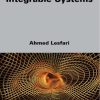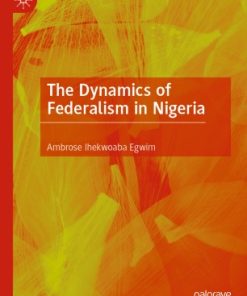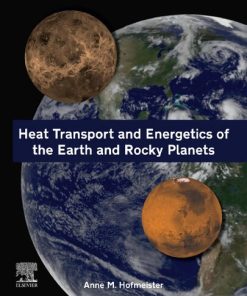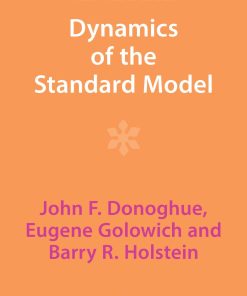The dynamics of natural satellites of the planets 1st edition by Nikolay Emelyanov 0128227121 9780128227121
$50.00 Original price was: $50.00.$25.00Current price is: $25.00.
The dynamics of natural satellites of the planets 1st edition by Nikolay Emelyanov – Ebook PDF Instant Download/DeliveryISBN: 0128227121, 9780128227121
Full download The dynamics of natural satellites of the planets 1st edition after payment.
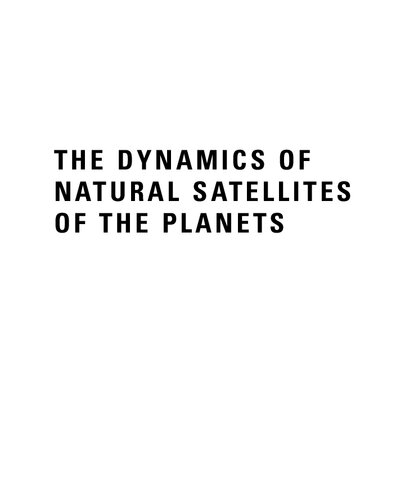
Product details:
ISBN-10 : 0128227121
ISBN-13 : 9780128227121
Author: Nikolay Emelyanov
The Dynamics of Natural Satellites of the Planets is an accessible reference for understanding the celestial mechanics of planetary moons through the lens of both theory and observation. Based on decades of research by the author, the book utilizes state-of-the-art observations of the natural satellites in the solar system to establish models, measurements and calculations to better understand the theory of the satellite movement and dynamics. It presents an extensive set of study methods and results on the motion of natural satellites of the planets and includes reviews and references to related publication for further explanation.
By relating observations to numerical theory, the book serves as a quick and comprehensive reference for applying the theory of orbital dynamics to observational data on orbits and physical properties of the natural satellites in order to formulate state-of-the-art explanations and models, particularly for determining the parameters of satellite motion.
The dynamics of natural satellites of the planets 1st Table of contents:
1: Objectives, current problems and general approach to the study of the dynamics of satellites
Abstract
1.1. Introduction
1.2. Celestial mechanics—the basis for studying the dynamics of planetary satellites
1.3. Objectives of studying the dynamics of planetary satellites
1.4. Basic concepts of celestial mechanics and astrometry
1.5. General approach to studying the dynamics of planets and satellites based on observations
1.6. Special properties of necessary observations
2: Satellites of planets
Abstract
2.1. Satellites of the planets—objects of the solar system
2.2. Classification and nomenclature of planetary satellites
2.3. Discovery of Neptune and its satellite, Triton
2.4. The history of the discovery of Pluto’s satellite, Charon
2.5. Orbital and physical parameters of planets with satellites
2.6. Orbital parameters of planetary satellites
References
3: Equations of motion and analytic theories
Abstract
3.1. Equations of motion and coordinate systems
3.2. Keplerian motion model
3.3. Force function of attraction of a non-spherical planet
3.4. An approximate account of the influence of the main satellites on the motion of distant satellites of the planet
3.5. Various approaches and methods for constructing motion models of planetary satellites
3.6. A model of motion of a satellite of an oblate planet based on the solution of the generalized problem of two fixed centers
3.7. Constructing analytical theories of planetary satellite motion using perturbation theory methods
3.8. Expansion of the perturbing function with respect to the elements of the intermediate orbit of a planetary satellite
3.9. Determination of perturbations of elements of the planetary satellite intermediate orbit
3.10. Constant perturbation of the semi-major axis of the satellite’s orbit
3.11. Precessing ellipse model
3.12. Perturbed motion at small eccentricities of the orbits
3.13. Constructed analytical theories of planetary satellite motion
3.14. Influence of tides in viscoelastic bodies of planet and satellite on the satellite’s orbital motion
References
4: Modeling the satellite motion. Numerical integration methods
Abstract
4.1. The objective of solving the equations of motion of celestial bodies
4.2. General properties of methods for the numerical integration of equations of motion
4.3. Runge–Kutta integration method for ordinary differential equations
4.4. Algorithm for solving problems of motion of a celestial body by numerical integration methods
4.5. Instructions for the computational program for the numerical integration of ordinary differential equations by the Everhart method
4.6. Belikov program for numerical integration of ordinary differential equations
4.7. Testing and comparing some numerical integration procedures
4.8. Approximation of the rectangular coordinates of planets and satellites by truncated Chebyshev series
4.9. Overview of problems and methods of numerical integration. Book by Avdyushev
References
5: Observations of planetary satellites
Abstract
5.1. General principles of observations
5.2. Determination of topocentric positions of planets and satellites
5.3. Planet observations
5.4. Observations of a planetary satellite
5.5. Observations of two satellites of the planet
5.6. Determination of angular measured values during observations of planetary satellites
5.7. Calculation of the angular distance between satellites and position angle
5.8. Determination of tangential coordinates of satellites
5.9. Determination of the coordinate difference between two satellites of the planet in the case of photometric observations of mutual eclipses of satellites
5.10. Conclusion regarding measured values during observations of planetary satellites
5.11. The moment of apparent approximation of planetary satellites as a measurable quantity during observations
5.12. Means and techniques of ground-based observations of planetary satellites
5.13. Sources of observations from planetary satellites
5.14. Time scales and coordinate systems for observations of planetary satellites
References
6: Construction of models for the motions of celestial bodies based on observations
Abstract
6.1. Method of differential refinement of the motion parameters of celestial bodies based on observations. Application of least-squares method
6.2. Weak conditionality and ambiguity of solution
6.3. Overview of filtering algorithms
6.4. Calculation of measured values and partial derivatives of the measured values by refined parameters
6.5. Assigning weights to observations and conditional equations
6.6. Calculation of statistical characteristics of residuals
6.7. The problem of rejecting rough observations
References
7: Obtaining astrometric data from observations of mutual occultations and eclipses of planetary satellites
Abstract
7.1. Description of phenomena
7.2. Method for obtaining astrometric data
7.3. A simplified model of mutual occultations and eclipses of planetary satellites
7.4. Photometric models of mutual occultations and eclipses of planetary satellites
7.5. The laws of light scattering for planetary satellites
7.6. Disk-integrated photometric characteristics of the satellite
7.7. Photometric models of mutual occultations and eclipses of the main satellites of Saturn and Uranus
7.8. Relation for the accuracy of astrometric results of observations of various types
7.9. Worldwide campaigns on observations of satellites during their mutual occultations and eclipses
7.10. Obstacles to improving the accuracy of astrometric results
7.11. Periods of the phenomena in the future
References
8: Estimation of the accuracy of planetary satellite ephemeris
Abstract
8.1. Factors determining ephemeris accuracy
8.2. Estimation of the ephemeris accuracy using observation-errors variance by the Monte Carlo techniques
8.3. Estimation of ephemeris accuracy by varying the composition of observations using “bootstrap”-samples
8.4. Estimation of the accuracy of ephemeris by the method of motion parameter variation
8.5. The accuracy of the ephemeris of the distant satellites of major planets
References
9: The rotation of planetary satellites
Abstract
9.1. General properties of the rotation of planetary satellites
9.2. Basic concepts of the rotation of planets and satellites
9.3. The rotation of Neptune and the orbit of Triton
9.4. Theory of rotation for Phobos
9.5. Rotation of the Galilean satellites of Jupiter, satellites of Saturn and Pluto
9.6. Chaotic rotation of planetary satellites. Rotation of Hyperion
References
10: The evolution of the orbits of the planetary satellites
Abstract
10.1. The impact of various factors on the evolution of the orbits of planetary satellites
10.2. The evolution of the orbits of satellites subject to the predominant influence of planet oblateness
10.3. Evolution of the orbits of the planetary satellites under the action of the solar attraction
10.4. Refined models of the evolution of the orbits of planetary satellites. Numerical analytical method
10.5. The evolution of the orbits of planetary satellites under the combined influence of various factors
10.6. Classification of the orbits of the distant satellites of Jupiter, Saturn, Uranus, and Neptune according to the types and properties of the orbit evolution
10.7. The evolution of the orbits and rendez-vous occurrences of distant satellites of the planets
10.8. Refinement of the Laplace–Lagrange secular perturbation theory
References
11: Physical parameters of planetary satellites
Abstract
11.1. Introduction
11.2. Handbook of the physical parameters of planetary satellites
11.3. Detection of volcanoes on the satellite of Jupiter Io using ground photometry
11.4. Estimates of the physical parameters of distant planetary satellites
11.5. Determination of Himalia’s mass from astrometric observations of other satellites
References
12: Recent models of planetary satellite motion. Information resources
Abstract
12.1. Variants and change of version of motion theories and ephemeris of planetary satellites
12.2. Means of providing access to databases, motion models and ephemeris of planetary satellites
12.3. MULTI-SAT ephemeris server features
12.4. Theories and models in the MULTI-SAT ephemeris server
12.5. Theories and models in the JPL ephemeris server
12.6. Planet satellites in virtual observatories
12.7. Standards of fundamental astronomy
People also search for The dynamics of natural satellites of the planets 1st:
natural satellites of planets are called
the definition of a natural satellite
the sun’s natural satellites
a natural satellite that orbits a planet
a natural satellite that revolves around a planet
Tags: The dynamics, natural satellites, the planets, Nikolay Emelyanov
You may also like…
Religion & Spirituality - Religious Studies
Politics & Philosophy - Anthropology
Politics & Philosophy
Science (General)
Heat Transport and Energetics of the Earth and Rocky Planets 1st Edition Anne Hofmeister
Uncategorized
History - Ancient History
Art, Science, and the Natural World in the Ancient Mediterranean, 300 BC to AD 100 1st Edition
Jurisprudence & Law - Foreign & International Law


